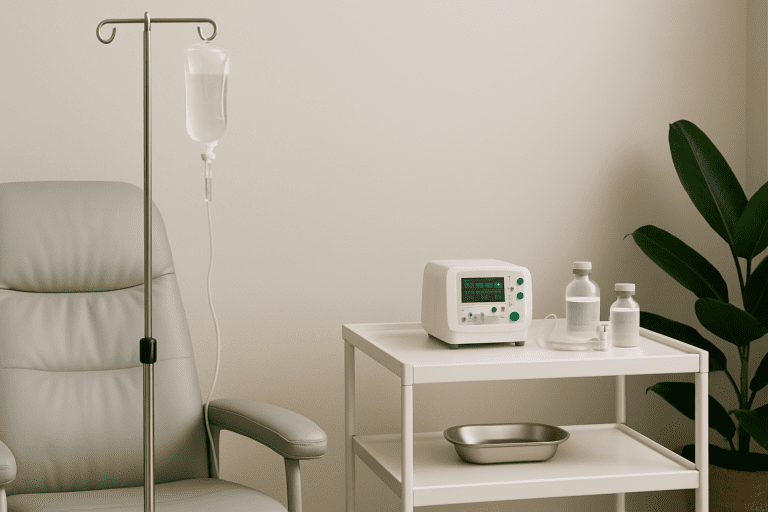Opening an IV therapy clinic requires more than a basic understanding of infusion protocols. The right equipment and furnishings are foundational to clinical performance, patient safety, and overall client experience. Each item in your setup serves a specific role, contributing to the efficiency of your workflow and the reputation of your practice. Whether you’re building your clinic from scratch or upgrading an existing setup, having a comprehensive checklist ensures you meet medical standards and patient expectations. In this guide, we’ll cover everything your IV therapy clinic needs to operate safely, efficiently, and professionally. From clinical-grade infusion devices to client comfort seating, every area of the clinic demands focused attention. This breakdown is designed for those who are already familiar with the clinical environment and want a 360-degree understanding of the must-have items in a modern IV therapy practice. Let’s walk through the core equipment, critical supplies, and support furnishings that no IV clinic should go without. The recommendations reflect current best practices and regulatory expectations in outpatient IV therapy centers. You’ll also find insights into how to source, set up, and maintain these essential assets for long-term success. What clinical-grade equipment is required for IV therapy? At the center of every IV therapy operation is the infusion system. Most clinics use either manual gravity infusion systems or electronic infusion pumps. For clinics offering complex formulations, precision dosing, or multi-hour drips, electronic pumps are preferred. They deliver fluids at a consistent, programmable rate and often include built-in alarms and safety mechanisms. Every IV therapy clinic must also have certified medical-grade refrigerators. These are used to store temperature-sensitive medications and vitamins such as glutathione, vitamin C, or biologics. Standard household fridges are not suitable, as they lack the temperature stability and monitoring features required for medical storage compliance. Emergency equipment must also be in place. At minimum, this includes an automated external defibrillator (AED), oxygen supply with a regulator and masks, a crash cart stocked with emergency medications, and a blood pressure monitor. Clinics should also maintain a thermometer, pulse oximeter, and EKG device if offering more advanced treatments. Every item must be tested regularly and documented according to local regulations. How should IV administration areas be set up? The patient infusion area should be clean, comfortable, and built around both clinical safety and customer service. IV poles, either free-standing or wall-mounted, are needed in each treatment station. Most clinics use wheeled IV poles for mobility. Each pole should have adjustable hooks and be sturdy enough to handle multiple bags if necessary. Recliner chairs with vinyl or antimicrobial upholstery are ideal for client seating. These chairs should be adjustable and easy to clean. They provide the client with comfort during treatments that can last from 30 minutes to several hours. Each seating area should have immediate access to a sharps container, a hand sanitizer dispenser, and a biohazard waste bin. Clinics must also provide treatment trays or carts at each station. These hold syringes, alcohol wipes, butterfly needles, IV start kits, and tourniquets. Keeping them within arm’s reach helps the clinician remain efficient and reduce unnecessary movement during catheter placement. Organization is key to smooth clinical operations, especially during high-volume periods. What supplies are needed for safe and effective IV administration? A fully operational IV therapy clinic requires a large stock of intravenous therapy supplies to ensure safe, consistent treatments. These include IV catheters of various gauges, sterile saline flushes, extension sets, IV tubing, alcohol prep pads, and transparent dressing films. Clinics must stock multiple catheter sizes to accommodate varying vein access needs, from small to large calibers. Syringes, needles, and vials must be stored according to manufacturer guidelines. Clinics also need butterfly sets, tourniquets, and securement devices. Labeling supplies such as medication stickers and time-tracking tags help maintain accuracy in charting. All consumables must be stored in a clean, dry area that is easy for staff to access while following infection control protocols. Proper personal protective equipment (PPE) is also non-negotiable. Gloves, masks, gowns, and face shields should be available to all clinical staff. Nitrile gloves are preferred over latex due to allergy concerns. Clinics should have a reliable stock management system to ensure that reordering is done before supplies run low. What furnishings contribute to client comfort and operational flow? Client experience in an IV therapy clinic is heavily influenced by the furnishings beyond the medical equipment. The waiting area should include soft chairs, a reception desk, a water station, and calming lighting. Some clinics provide tablets for intake forms and entertainment or reading material to enhance the visit. Each treatment room or station should have sound-absorbing panels if located in a high-traffic environment. This helps protect privacy and maintain a relaxing atmosphere. Adjustable lighting allows clinicians to work accurately while keeping patients comfortable. Behind the scenes, storage cabinets, staff lockers, and labeled shelving help maintain an orderly environment. A clean, organized layout reduces the chances of misplaced items and improves infection control. Lockable medicine cabinets are also required for storing controlled substances or restricted items. Clinical break rooms and private staff areas are important for morale and professionalism. How should clinics handle sanitation and infection control? Sanitation infrastructure is crucial in an IV therapy setting. Each station must have access to a handwashing sink or sanitizing station. Surfaces should be non-porous and easy to disinfect between clients. UV sanitation lights or HEPA-filtered air purifiers are often used to keep treatment areas safe, especially in smaller rooms with limited airflow. Daily cleaning protocols should include surface disinfection, mopping of all floors, and waste disposal according to biohazard protocols. Sharps containers should be replaced before they reach the fill line, and biohazard bags should be securely tied and disposed of according to state guidelines. Clinics must also post visible signage outlining proper hand hygiene and PPE procedures for both staff and clients. These small touches reinforce safety standards and create trust with clients who may be nervous or new to IV therapy. What technology infrastructure supports an efficient IV therapy








